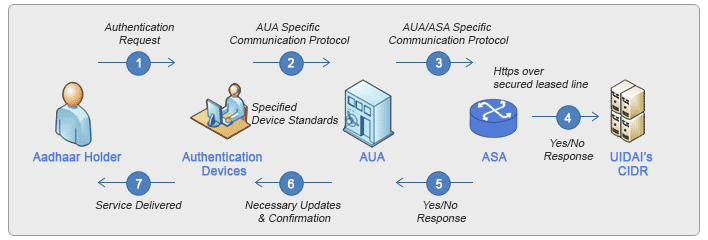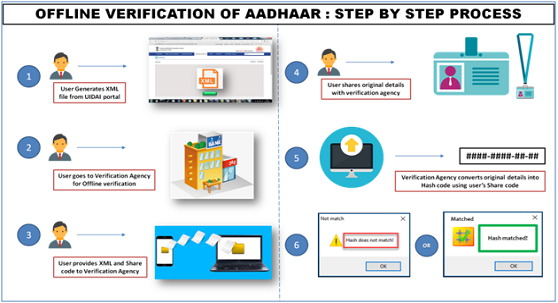Operation Model
This operating model outlines the actors involved in the Aadhaar Authentication ecosystem. The following figure identifies the key actors in the Aadhaar authentication model and depicts the data flow in which the key actors could engage with each other. The brief description of key actors and the scenarios in which they engage with each other are indicated in the figure below .

Stakeholders in Aadhaar Authentication Ecosystem
"Aadhaar number holder" means an individual who has been issued an Aadhaar number under the Act
"Authentication" means the process by which the Aadhaar number along with demographic information or biometric information of an individual is submitted to the Central Identities Data Repository for its verification and such Repository verifies the correctness, or the lack thereof, on the basis of information available with it
"Authentication facility" means the facility provided by the Authority for verifying the identity information of an Aadhaar number holder through the process of authentication, by providing a Yes/ No response or e-KYC data, as applicable
"Authentication Service Agency" or "ASA" mean an entity providing necessary infrastructure for ensuring secure network connectivity and related services for enabling a requesting entity to perform authentication using the authentication facility provided by the Authority
"Authentication User Agency" or "AUA" means a requesting entity that uses the Yes/ No authentication facility provided by the Authority
"Central Identities Data Repository"" or ""CIDR"" means a centralised database in one or more locations containing all Aadhaar numbers issued to Aadhaar number holders along with the corresponding demographic information and biometric information of such individuals and other information related thereto
Authentication Devices: These are the devices that collect PID (Personal Identity Data) from Aadhaar holders, encrypt the PID block, transmit the authentication packets and receive the authentication results. Examples include PCs, kiosks, handheld devices etc. They are deployed, operated and managed by the AUA/Sub AUA."
Process of sending authentication requests
1. After collecting the Aadhaar number or any other identifier provided by the requesting entity which is mapped to Aadhaar number and necessary demographic and / or biometric information and/ or OTP from the Aadhaar number holder, the client application shall immediately package and encrypt these input parameters into PID block before any transmission, as per the specifications laid down by the Authority, and shall send it to server of the requesting entity using secure protocols as may be laid down by the Authority for this purpose
2. After validation, the server of a requesting entity shall pass the authentication request to the CIDR, through the server of the Authentication Service Agency as per the specifications laid down by the Authority. The authentication request shall be digitally signed by the requesting entity and/or by the Authentication Service Agency, as per the mutual agreement between them.
3. Based on the mode of authentication request, the CIDR shall validate the input parameters against the data stored therein and return a digitally signed Yes or No authentication response, or a digitally signed e-KYC authentication response with encrypted e-KYC data, as the case may be, along with other technical details related to the authentication transaction.
4. In all modes of authentication, the Aadhaar number is mandatory and is submitted along with the input parameters specified in sub-regulation (1) above such that authentication is always reduced to a 1:1 match.
5. A requesting entity shall ensure that encryption of PID Block takes place at the time of capture on the authentication device as per the processes and specifications laid down by the Authority."
The key actors could engage with each other in multiple ways. For example, an AUA could choose to become its own ASA, an AUA could access Aadhaar authentication services through multiple ASAs for reasons such as business continuity planning, an AUA transmits authentication requests for its own service delivery needs as well as on behalf of multiple Sub AUAs.





